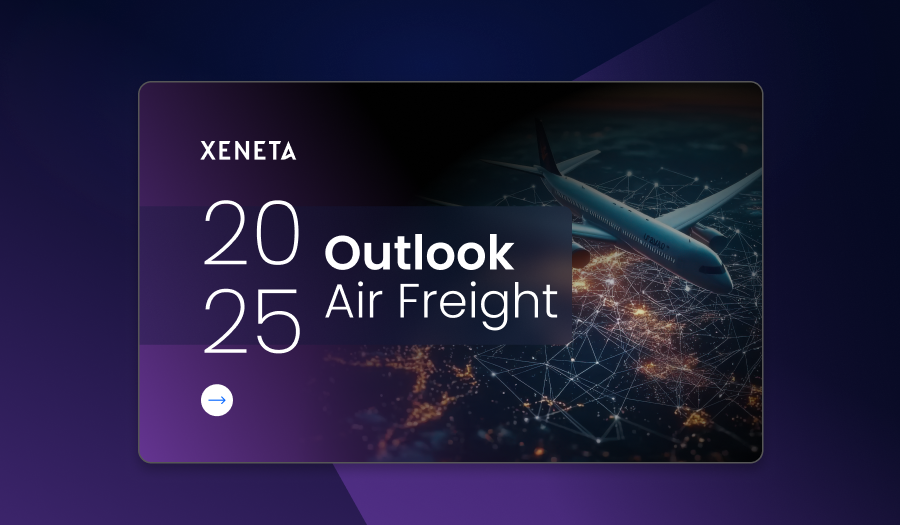For procurement professionals, finding cost-effective freight solutions while maintaining service levels and reliability is a constant balancing act.
You face immense pressure to optimize supply chain costs amid rising inflation and tighter margins. And you’re expected to outperform the market with leaner teams and external forces tearing up the validity of contracted rates.
Couple this with fluctuating demand, capacity constraints, and disruptions in global supply chains and the onerous task of budgeting becomes ever more complicated.
Unpredictable as it may be, your CFO still expects you to stay on budget.
So, how are you planning ahead?
Will you continue to frontload inventory to avoid the introduction of tariffs on Chinese goods, or will you budget for the return of more stable freight rates instead?
With geopolitics threatening the stability of trade by air and ocean, how much buffer will you build into your budgets to mitigate against potential delays, rerouting, and extended lead times?
Have you planned for possible overcapacity or underuse of contracted freight space in light of rapid fluctuations in consumer demand?
Without reliable market forecasts, predicting future rates for the 2025 budget will be time-consuming, unsubstantiated and in a lot of cases, costly.
And because every supply chain is different, there’s no ‘one size fits all’ answer. But there are steps you can take to more confidently budget for 2025.
Meeting budgeting challenges head on
Peter Sand’s recent blog gives context around the scale of budgeting challenges in an age of intense geo-political turmoil and uncertainty in ocean container shipping.
This blog builds on Sand’s analysis, delivering five winning strategies to help master 2025 budgets, and examples of how real-time, crowdsourced data strengthens your procurement negotiations (and ongoing freight spend).
For freight budget holders, this blog gives you permission to embrace dynamic pricing strategies and spend more time looking at your market position. The more proactive you are, the less time you’re going to spend ad hoc fielding rates.
For those impacted by budget decisions but not directly responsible, this blog identifies potential gaps in your organization's budget strategy – gaps that can see your cargo rolled when peak capacity hits (preventing your goods getting to where they need to, when they need to be there) and panic bargaining when freight rates reach market-high levels (meaning your team will spend more time securing above-average rates that will eat into your profit margins).
Gaps that will impact your overall company performance if not addressed.
Strengthen Your 2025 Freight Budget Plan with these Five Essential Strategies
1. Anticipate future spending with historical and real-time data
Historical market data can show you how rates on the largest global corridors have changed between the present day and years in the past. This is important for tracking the success of your budget strategy against past performance, as well as others in the market.
However, historical market data as a sole basis for future budgeting does not guarantee accuracy – especially when market volatility is considered.
For instance, if your 2024 budget needed to take into account the cost of shipping goods via air, looking to data from summer 2023 to predict air cargo availability and rates could not have prepared your business for the double-digit demand growth seen in August 2024 – with average spot rates showing their largest year-on-year growth of +24%.
With this in mind, shippers are advised to adopt a two-pronged approach.
Rather than looking solely to the past, you need to spend an equal amount of time understanding your relative position in the market. This includes understanding your real-time market position in relation to your peers, and following short-term market changes more closely – since they often reflect upcoming long-term trends.
Having access to real-time data will also show you the exact day-to-day financial impact it’s having on your freight rates.
2. Use forward-looking data to stay ahead of trends
The short-term market is often a strong indicator of long-term pricing, and current contracts should be assessed to gauge future spending patterns. Not only will this support the development of a 2025 budget, but constant monitoring of the market will also support conversations around budget increases and help justify additional spend, such as unplanned surcharges and tariffs.
Contracted rates that extend past the present day, or are signed but scheduled to start in the future, can also provide valuable insight. Not only does it offer a unique look into the softening or rising of markets, it can help you anticipate trends specific to your trade lanes ahead of 2025 budgeting decisions.
Did you know? With Xeneta, you can view both long-term and short-term rates that are valid up to 3 months and 10 days ahead. If you're interested in our product plans for predicting future market trends, we'd love to chat with you.
3. Understand why the market shifts
When the market is in the shippers’ favor, financial success is easier to achieve than if the market is spiking. Maintaining that success when the market shifts is significantly harder. And part of the reason it gets harder is because the supply chain is an increasingly complex, interconnected organism – so not only do your own decisions have a knock-on effect, but any changes you make must also mitigate ripple effects caused by external forces.
When it comes to budgeting in these sorts of market conditions, you need two things:
Real-time data:
People can predict trends, but no one can predict the exact figures shippers are looking for – real-time data is the only accurate window into the market.
Types of data to consider monitoring during your budget process:
- Long-term and short-term freight rates
- Market spread. As well as the market spread between TEU and FEU freight costs
- Integrated Container Type Comparisons
- Flexible Origin-Destination Comparisons: Compare single origins with multiple destinations, especially useful during Black Swan events.
- Comprehensive Carrier Comparisons: Optimize supplier selection by comparing all carriers simultaneously.

Above is a screenshot from the Xeneta platform.
Market context:
While real-time data will show you the movement of freight rates, understanding how and why these rates are moving is critical. With this additional context, you can better understand how long a particular trend will last, but also which factors are impacting your schedule reliability, transit times and overall service levels. This will allow you to adjust your budgets to accommodate potential costs associated with expedited shipping, alternative routes, or additional inventory holding costs to maintain customer service levels.
Monitoring the market and mapping freight movements against global events can help establish an educated opinion of why the market behaves in a particular way. This, in turn, enables you to make data-informed decisions about when to procure, which routes and manufacturing hubs to use, and when to push your LSPs for lower rates.
Additional market context can also be gained from trusted industry reports such as the 2024 Outlook Mid-Year Ocean Freight Update.
4. Align Internal Teams for Greater Budget Accuracy
Modernizing internal processes can be a difficult change, but if the change provides significant future financial & organization benefits, it’s riskier to stay exactly as you are.
Alignment between your logistics and finance teams is essential for accurate budgeting. External factors such as weather and geopolitical events are often sudden, incalculable and significantly affect logistics costs. This means that no matter how diligent your procurement manager was in creating a 2024 budget, events such as the Red Sea crisis saw budgets torn up just two months into the new year, because costs had increased by USD 6.88 million per month.
Ensuring all supply chain executives understand the relationship between freight rates and factors such as schedules, capacity, and carrier strategies can help facilitate urgent requests, improve cross-team knowledge and collaboration and move the focus of negotiations away from chasing the final dollar.
As Mauricio Cantisani, Global Category Procurement Manager at British American Tobacco, observed, aligning their global teams around Xeneta as a reliable source of market intelligence gave them confidence to create scalable outcomes and success.
“Our team has become so much more efficient and productive now that we’re connected to the market through Xeneta. With trusted data at our fingertips, we have eliminated the stress of the unknown and there’s no more silent pressure internally on cost, budget, or negotiations.”
5. Get back in the driving seat with index-based contracts
The unpredictable nature of global supply chains is driving the freight industry towards dynamic pricing models and index-based contracts.
Not only are they sensitive to changes in capacity availability, they reflect the real-time fluctuations and complexities of the freight market, allowing for more accurate and flexible budgeting. Understanding these fluctuations enables procurement professionals to respond to price shifts and agree more favorable terms with carriers and logistics providers.
For those who are concerned about indexed freight rates climbing to the lofty heights of market-highs, agreeing price caps and floors in index-based contract adds security – security you don’t get when playing the spot-market. And when you consider that contracted rates aren’t always honored during supply chain disruptions, chances are, your budgets are already vulnerable to extreme fluctuations in freight rates.
What’s more, they are valuable for scenario planning, helping procurement managers model potential outcomes and negotiate more favorably. They also save time and resources by removing the need for constant renegotiations every time there’s a turn in the market.
If you’re looking to safeguard your budgets against extreme fluctuations, index-linked contracts offer a viable solution. But be warned. If you’re going to commit, it's critical you have access to both FEU and TEU data.
There is such a thing as “too late” in supply chain.
Procurement managers preparing a 2025 budget for ocean container shipping and committing to long term decisions may be wise to wait for the outcome of ILA negotiations on 1 October that threaten strikes at US East Coast and Gulf Coast ports, as well as the results of the US presidential elections.
However, these aren’t the only factors at play and there is a clear need to work pro-actively.
The impact of global uncertainty can be mitigated by securing access to freight intelligence, building flexibility into contracts, and staying informed of global developments that could impact freight costs and capacity.
Wait too long to modernise how you budget, and you could face:
- Serious delays that impact the entire supply chain; causing customer dissatisfaction, pay demurrage and detention charges, and in some cases, the closure of factories until inventory arrives.
- You’ll need to absorb an increased spend per TEU to get goods moving (not just from elevated freight rates, but surcharges and tariffs too) – and explain how your peers managed to avoid paying the same costs.
- Without real-time data or historical trends, you’ll have a hard time justifying why you are millions above budget. You’ll also likely spend hours having ad-hoc conversations with your LSPs trying to reclaim dollars lost.
- Any overspend will eat into your margins and sales, and undermine the accuracy of future forecasts.
- The impact of these decisions (or lack of) will be felt across the organization; not to mention the levels of stress you’ll inherit on a professional level.
The solution is simple. Proactive planning, relying on the right data, and being ready to adapt as market conditions evolve.
And you can start today.
With Xeneta’s granular market data, you can make informed decisions, optimize supplier selection, and fine-tune contract lengths and tender timing, all of which help ensure your budget stays on track. By being proactive and utilizing accurate data, you’ll avoid costly surprises and keep your 2025 budget aligned with market realities, no matter what challenges arise in the global freight landscape.







